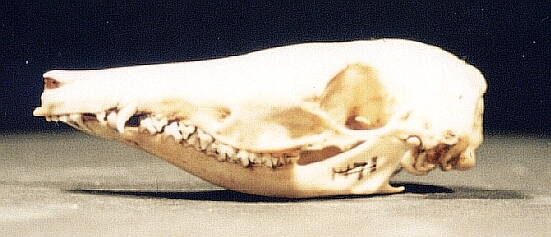

|
ANATOMICAL DIFFERENCES BETWEEN MARSUPIAL AND PLACENTAL MAMMALS |

|
Marsupial Skulls
The marsupial skull generally has a large face area, but only a small brain case.
The rest of the skull is similar to a primitve mammal, with the eye socket and opening for the
temporal muscles running together. Where the skulls of marsupials do differ from
placentals is that typically the rear part of their jaw is turned inward
(inflected jaw angle) rather than outward.
We also see a difference in the dentition of marsupials. Marsupials on the whole have
more teeth than placental mammals. Marsupials may have 3 premolars and 4 molars on each side in both
the upper and lower jaw (P3/3; M4/4). In placental mammals the general dental
formula is 4 premolars and 3 molars on either side in both the upper
and lower jaw (PM 4/4; M 3/3).
Marsupials which have 4 or more lower incisors are termed polyprotodont,
for example the bandicoot which is insectivorous, has small even teeth of equal size,
with sharp cusps for crushing insects. The bandicoot's dental
formula is I4-5/3; C1/1; PM3/3; M4/4.
Whereas placental mammals typically have two sets of teeth, marsupials replace only some of their teeth.

A Bandicoot skull.
Diprotodont marsupials, e.g. brushtail possums and common wombats, have only two lower incisors, which are usually large and forward facing.
Pouches
Marsupials are most easily distinguished from Eutherian mammals by the possession of a pouch. Although the typical image of a female marsupial is of an animal with a single offspring living in a pouch on the front of her abdomen, there are many types of pouches and some species do not have a pouch at all.
|
 |
Anatomy of Reproduction
The reproductive anatomy of marsupials also distinguishes them from Eutherian mammals.
The female reproductive system is very unusual in that it is almost
entirely doubled. Females have a posterial urogenital sinus which recieves two lateral vaginae
and the urethra. One of a pair of uteri and then a cervix leads from the top of each vagina.
Fertilisation occurs via either of the vaginae. At the time of birth the
two vaginae fuse to form a 'median vagina' or 'pseudo birth canal'. In some species, e.g. the brushtail possum, the
septum which was breached during birth reforms; in others, e.g. the grey kangaroo, this median canal remains open permanently.
The reproductive system of the male is much more similar to Eutherian mammals than that of the
female. The main differences in the male are external rather than internal and comprise
a bifurcate penis which is posterior to the scrotum. When flaccid, the penis is held in
an S-shaped curve withdrawn into the body.






